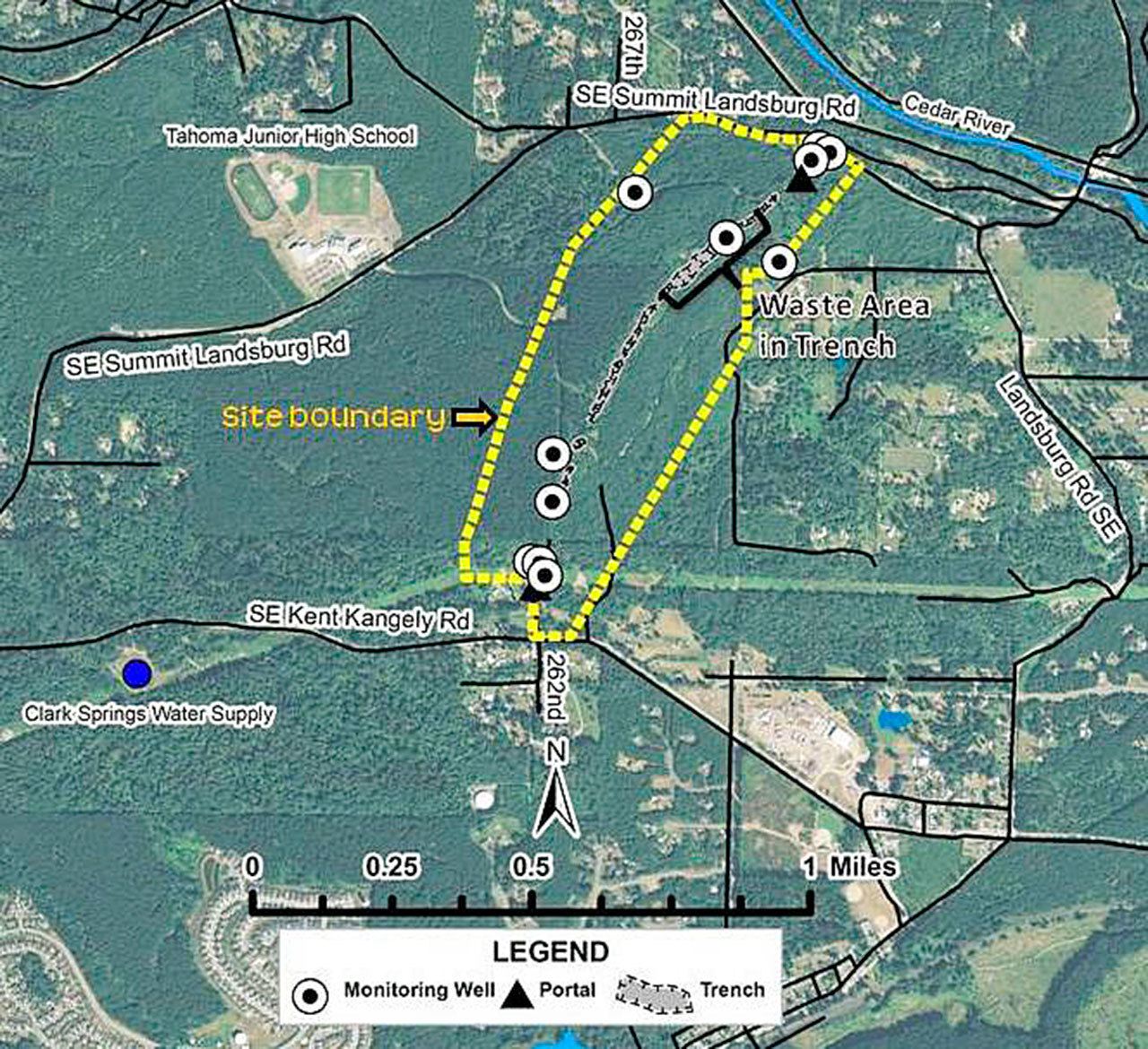The state Department of Ecology expects to begin an estimated $3.9 million cleanup this spring of a longtime industrial waste site that sits near the primary source of Kent’s drinking water.
City and state officials – and potential liable parties – have spent nearly two decades trying to come up with the best ways to clean up the site, which is a trench above the old Landsburg underground coal mine near Ravensdale, east of Kent. The trench stretches about three-fourths of a mile long and goes 20 to 60 feet deep just north of the Clark Springs watershed, where much of the city’s water supply comes from.
Kent also gets water from the city of Tacoma from the Green River watershed as a regional partner.
Several companies dumped nearly 500,000 gallons of waste from 1969 to 1978 at the Landsburg mine site. The nearly 4,500 barrels contain paint waste, solvents, heavy metals, oily water and sludge, according to state documents. The Cedar River is about 500 feet from the site.
Technical contractors hired by the potential liable parties installed 11 wells to help monitor the site since the 1990s and so far there has been no impacts to groundwater at the site or surrounding sites.
But all parties are ready to move forward with the cleanup – actually more of a containment plan – to help make sure the buried industrial waste never reaches Kent’s drinking water.
“We have arms around the site for the investigation work that we’ve done and we have designed the cleanup on paper,” said Bob Warren, a toxics cleanup program manager for the state DOE, at a Jan. 17 City Council workshop. “But the cleanup hasn’t began yet. We don’t have the responsible parties under a consent decree requiring them to do the work. We don’t have the wells in place that we want to have in place to manage this long term.”
A consent decree is a settlement that resolves a dispute between two parties without admission of liability in a civil case. A judge, the state DOE and the responsible parties must sign a consent decree for the cleanup to move forward and the costs to be covered, Warren said.
“We don’t have financial assurance in place that will ensure that the responsible parties have money put aside to manage this for the long term,” Warren said. “We don’t have a lot of things yet that we really do need, but we have been talking with the city of Kent about how important this is going to be to move this cleanup forward and get this site under a consent decree.”
The responsible companies include Browning-Ferris Industries of Illinois, Inc.; BNSF Railway; PACCAR, Inc.; Plum Creek Timberlands, L.P.; TOC Holdings Co.; and Palmer Coking Coal Co., which owns the property where the waste was dumped.
Councilman Les Thomas asked Warren about the buried waste barrels and how the state determines who will pay how much for the cleanup.
“As I understand it this is just full of barrels, like 50-gallon barrels of contaminated barrels,” Thomas said. “How do you know who is responsible, 10 percent this company, 20 percent this company and are they even around anymore? So how do you determine those?”
Warren responded that one company (the Phillips Services Corp.) has gone bankrupt and is no longer in the process.
“But there are (six) more responsible parties in line and are still ready and able to move forward,” Warren said. “But we really do need to get them under a consent decree and have those parties able to construct a financial assurance mechanism to get funds put away so if another responsible party disappears the financial mechanism is still there.”
It will cost about $3.9 million for the cleanup plan, Warren said in an email. Crews will need to install additional wells as part of the cleanup plan to help monitor the site for many years.
Although groundwater remains safe around the site, that could change if waste materials leak. The state DOE rates the site a one based on a one-to-five scale with one ranking as a high concern and five as the least concern.
“It’s a one,” Warren said. “That’s why we want to move forward.”
If a consent decree is signed soon, crews will begin cleanup work in the spring and complete it by spring 2018, Warren said. The process includes using a soil cap to help contain the waste.
“The Engineering Design Report (EDR) has not been drafted, reviewed and approved by Ecology yet, but the cap or cover typically consist of trench (mine seam) backfilled and a low-permeability soil cap on top of that backfill,” Warren said in an email. “The soil cap will be landscaped to divert stormwater to minimize rainfall infiltration.”
Warren said a low-permeability soil cap consists of 24 inches of compacted soil beneath six inches of vegetated topsoil.
The state Department of Health also studied the Landsburg site and determined the buried wastes could pose a potential threat.
“What we have found in the area is nothing has escaped the site that presents a threat to the public health,” said Joanne Snarski, state DOH site assessments manager, at the council workshop. “But the contaminants that remain in the disposal area of the dump – they pose a threat.”
For more information, go to the state DOE website at https://fortress.wa.gov/ecy/gsp/Sitepage.aspx?csid=60.
Talk to us
Please share your story tips by emailing editor@kentreporter.com.
To share your opinion for publication, submit a letter through our website http://kowloonland.com.hk/?big=submit-letter/. Include your name, address and daytime phone number. (We’ll only publish your name and hometown.) Please keep letters to 300 words or less.

